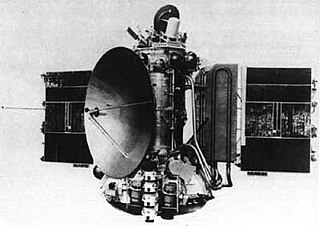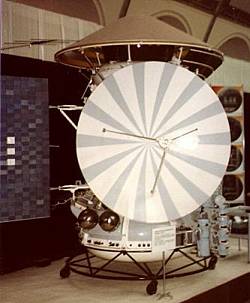
Venera 1, also known as Venera-1VA No.2 and occasionally in the West as Sputnik 8 was the first spacecraft to perform an interplanetary flight and the first to fly past Venus, as part of the Soviet Union's Venera programme. Launched in February 1961, it flew past Venus on 19 May of the same year; however, radio contact with the probe was lost before the flyby, resulting in it returning no data.
Mars 2MV-4 No.1 also known as Sputnik 22 in the West, was a Soviet spacecraft, which was launched in 1962 as part of the Mars programme, and was intended to make a flyby of Mars, and transmit images of the planet back to Earth. Due to a problem with the rocket which launched it, it was destroyed in low Earth orbit. It was the first of two Mars 2MV-4 spacecraft to be launched, the other being the Mars 1 spacecraft which was launched eight days later.
Mars 2MV-3 No.1 also known as Sputnik 24 in the West, was a Soviet spacecraft, which was launched in 1962 as part of the Mars program, and was intended to land on the surface of Mars. Due to a problem with the rocket which launched it, it did not depart low Earth orbit, and it decayed several days later. It was the only Mars 2MV-3 spacecraft to be launched.

Mars 4, also known as 3MS No.52S was a Soviet spacecraft intended to explore Mars. A 3MS spacecraft launched as part of the Mars programme, it was intended to enter orbit around Mars in 1974. However, computer problems prevented orbital insertion from occurring.
Mars 5, also known as 3MS No.53S was a Soviet spacecraft launched to explore Mars. A 3MS spacecraft launched as part of the Mars programme, it successfully entered orbit around Mars in 1974. However, it failed a few weeks later.

Mars 6, also known as 3MP No.50P was a Soviet spacecraft launched to explore Mars. A 3MP bus spacecraft launched as part of the Mars program, it consisted of a lander, and a coast stage with instruments to study Mars as it flew past.

Mars 7, also known as 3MP No.51P was a Soviet spacecraft launched in 1973 to explore Mars. A 3MP bus spacecraft which comprised the final mission of the Mars programme, it consisted of a lander and a coast stage with instruments to study Mars as it flew past. Due to a malfunction, the lander failed to perform a maneuver necessary to enter the Martian atmosphere, missing the planet and remaining in heliocentric orbit along with the coast stage.

The Mars 2 was an uncrewed space probe of the Mars program, a series of uncrewed Mars landers and orbiters launched by the Soviet Union beginning 19 May 1971. The Mars 2 and Mars 3 missions consisted of identical spacecraft, each with an orbiter and an attached lander. The orbiter is identical to the Venera 9 bus. The type of bus/orbiter is the 4MV. They were launched by a Proton-K heavy launch vehicle with a Blok D upper stage. The lander of Mars 2 became the first human-made object to reach the surface of Mars, although the landing system failed and the lander was lost.

Mars 3 was a robotic space probe of the Soviet Mars program, launched May 28, 1971, nine days after its twin spacecraft Mars 2. The probes were identical robotic spacecraft launched by Proton-K rockets with a Blok D upper stage, each consisting of an orbiter and an attached lander. After the Mars 2 lander crashed on the Martian surface, the Mars 3 lander became the first spacecraft to attain a soft landing on Mars, on December 2, 1971. It failed 110 seconds after landing, having transmitted only a gray image with no details. The Mars 2 orbiter and Mars 3 orbiter continued to circle Mars and transmit images back to Earth for another eight months.

Mars 1M was a series of two uncrewed spacecraft which were used in the first Soviet missions to explore Mars. They were the earliest missions of the Mars program. The Western media dubbed the spacecraft "Marsnik", a portmanteau of Mars and Sputnik.

Venera 2, also known as 3MV-4 No.4 was a Soviet spacecraft intended to explore Venus. A 3MV-4 spacecraft launched as part of the Venera programme, it failed to return data after flying past Venus.
Kosmos 419, also known as 3MS No.170 was a failed Soviet spacecraft intended to visit Mars. The spacecraft was launched on 10 May 1971, however due to an upper stage malfunction it failed to depart low Earth orbit.
In aerospace engineering, spin stabilization is a method of stabilizing a satellite or launch vehicle by means of spin, i.e. rotation along the longitudinal axis. The concept originates from conservation of angular momentum as applied to ballistics, where the spin is commonly obtained by means of rifling. For most satellite applications this approach has been superseded by three-axis stabilization.
Mars 2M No.522, also known as Mars M-69 No.522 and sometimes identified by NASA as Mars 1969B, was a Soviet spacecraft which was lost in a launch failure in 1969. It consisted of an orbiter. The spacecraft was intended to image the surface of Mars using three cameras, with images being encoded for transmission back to Earth as television signals. It also carried a radiometer, a series of spectrometers, and an instrument to detect water vapour in the atmosphere of Mars. It was one of two Mars 2M spacecraft, along with Mars 2M No.521, which was launched in 1969 as part of the Mars program. Neither launch was successful.
Mars 2M No.521, also known as Mars M-69 No.521 and sometimes identified by NASA as Mars 1969A, was a Soviet spacecraft which was lost in a launch failure in 1969. It consisted of an orbiter. The spacecraft was intended to image the surface of Mars using three cameras, with images being encoded for transmission back to Earth as television signals. It also carried a radiometer, a series of spectrometers, and an instrument to detect water vapour in the atmosphere of Mars. It was one of two Mars 2M spacecraft, along with Mars 2M No.522, which was launched in 1969 as part of the Mars programme. Neither launch was successful.
Luna E-3 No.1, sometimes identified by NASA as Luna 1960A, was a Soviet spacecraft which was lost in a launch failure in 1960. It was a 279-kilogram (615 lb) Luna E-3 spacecraft, the first of two to be launched, both of which were lost in launch failures. It was intended to fly around the Moon on a circumlunar trajectory in order to image the surface of the Moon, including the far side. The E-3 spacecraft were similar in design to the E-2A which had been used for the earlier Luna 3 mission. However, they carried higher resolution cameras, and were intended to make closer flybys.

Soyuz 7K-L1 No.5L, sometimes identified by NASA as Zond 1967B, was a Soviet spacecraft which was launched in 1967 as part of the Zond programme. It was a 5,390-kilogram (11,880 lb) Soyuz 7K-L1 spacecraft, the second of nine to be launched. It was intended to perform a circumlunar flyby of the Moon before returning to the Earth for landing, but failed to achieve Earth orbit.
Zond 3MV-1 No.2, also known as Venera 1964A in the West, was a Soviet spacecraft, which was launched in 1964 as part of the Zond program. Due to a problem with its carrier rocket third stage, it failed to reach low Earth orbit.

Mars 1M No.2, designated Mars 1960B by NASA analysts and dubbed Marsnik 2 by the Western media, was a spacecraft launched as part of the Soviet Union's Mars programme, which was lost in a launch failure in 1960. 1M No.2, which was intended to explore Mars from flyby trajectory, was destroyed after its Molniya carrier rocket failed to achieve orbit.
Kosmos 96, or 3MV-4 No.6, was a Soviet spacecraft intended to explore Venus. A 3MV-4 spacecraft launched as part of the Venera programme, Kosmos 96 was to have made a flyby of Venus, however, due to a launch failure, it did not depart low Earth orbit. Its re-entry into Earth's atmosphere is often speculated as the cause of the Kecksburg UFO incident.










